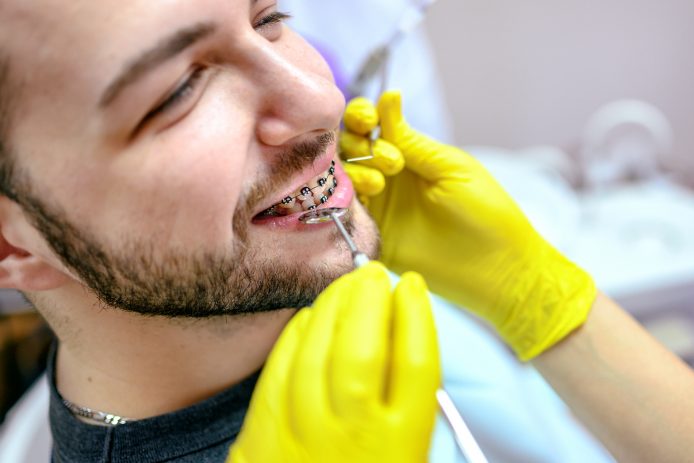How to Deal with Bracket and Wire Braces Emergencies

Archwire
The archwire is the main wire that guides the teeth. This wire is changed periodically throughout treatment as teeth move to their new positions.
Bracket
The bracket is a small attachment that is bonded directly to the tooth surface.
Coil Spring
The coil spring goes over the wire and is placed between brackets to help open space between teeth.
Tie Wire
This is a thin wire that is twisted around the bracket.
Band
The band is a thin ring of metal that is fitted around the tooth and cemented in place. The band has a bracket attached to it and is an alternative to bonding the bracket directly to the tooth itself.
Hook
The hook is a welded or removable arm that is used to attach rubber bands.
Elastic (Rubber Band)
The elastic is a small rubber band that is placed on hooks at different points in the mouth to provide pressure to move the teeth.
Problems:
True orthodontic emergencies are very rare. In general, you should call the office if you experience severe pain and the problem can not be fixed at home. We will schedule an appointment to make you comfortable.
Most problems can be temporarily solved by yourself, at home, until your next scheduled appointment. To help us better assist you, it is important that you know the basic terms and parts of the braces (listed on another page). Even if it is something you can take care of yourself, still call the office to schedule a time to repair the problem. Allowing the problem to remain for a long period of time may lengthen your treatment time. Call the office to inform us of a loose bracket regardless of what day or time your appointment is.
The following solutions may help you relieve your discomfort:
Loose bracket or band
- If your bracket is still attached to the wire, leave it in place and put wax on it.
- If the bracket comes off entirely, place the bracket in an envelope and bring it to your next appointment. The bracket will be reattached at your next regular visit.
Poking wire or elastic hook
- Use a Q-tip or pencil eraser to push wire flat against tooth.
- If still bothersome, use wax on the offending wire.
Archwire out of back bracket
- Use a tweezer to place wire back through tube.
- If frequently occurs, cut wire with a fingernail clipper behind the last tooth to which it is securely attached.
- If discomfort continues, place wax on it.
Turbo off – bracket behind front teeth
- If both off, save turbos and call the orthodontist.
- If one off, save turbo and inform orthodontist at next visit.
Coil spring off
- Save spring and inform your orthodontist. We will let you know if you need to be seen sooner or if the spring can be reinserted at the next regular visit.
Door of the bracket open
- Push wire into slot and push the door closed with finger.
Mouth Sores
- The lips, cheeks and tongue may become irritated for one or two weeks as they toughen and become accustomed to the surface of the braces.
- Apply a small amount of Orabase or Zilactin.
- Use a salt water rinse.
Discomfort and general soreness
- This is normal 3-5 days after braces are adjusted.
- Teeth may be tender to biting pressures.
- Take an over-the-counter pain reliever (ibuprofen).
- Eat soft foods.
- Rinse mouth with cold water or eat cold food (ice cream, popsicles).
Latest Orthodontic Articles
The confidence that comes with a great smile can change the way people see you, and the way you see…
It can be easy to overlook orthodontic treatment when you are planning a vacation, so it is important to plan…
A bright, white smile is an extremely attractive feature. If you still have dull or yellow teeth after your everyday…



